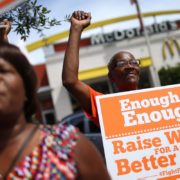The new policy, approved by Florida voters on Tuesday, could signal a momentum shift in favor of a nationwide minimum-wage hike.
On Election Day, Floridians voted to increase their state’s minimum wage to $15 per hour by 2026–yet businesses everywhere could feel the pain.
Florida’s Amendment 2, which passed with a “Yes” vote of 61 percent, will incrementally raise the state’s minimum wage to $15 per hour in six years, from its current $8.56 per hour. Florida is now the eighth U.S. state to incrementally raise its minimum wage to $15 per hour, and the first state to achieve it through a ballot initiative rather than congressional legislation. The distinction is important: Florida’s amendment is being viewed as a nationwide test for voter support, and it passed with flying colors.
“The stakes were higher,” says Josh Altic, who researches ballot measures at Ballotpedia, a nonprofit resource website for voters. “Not to just pass the measure in Florida, but to show that this issue could win by 10 percentage points in a state that President Trump won.”
— Credits
Featured Image, GETTY IMAGES
FULL ARTICLE @ INC.
— Related
The minimum wage in the United States is set by U.S. labor law and a range of state and local laws. Employers generally have to pay workers the highest minimum wage prescribed by federal, state, and local law. Since July 24, 2009, the federal minimum wage is $7.25 per hour. As of January 2020, there were 29 states and D.C with a minimum wage higher than the federal minimum. From 2018 to 2019, seven states increased their minimum wage levels through automatic adjustments, while increases in sixteen other states and D.C. occurred through referendum or legislative action.
While the federal minimum wage is $7.25, most states and many cities have higher minimum wages resulting in almost 90% of U.S. minimum wage workers earning more than $7.25. The effective nationwide minimum wage, the wage that the average minimum wage worker earns, is $11.80 as of May 2019. This is the highest it has been since at least 1994, the earliest year effective minimum wage data was available.
The purchasing power of the federal minimum wage peaked in 1968 at $1.60 ($12.00 in 2019 dollars). If the minimum wage in 1968 had kept up with labor’s productivity growth, it would have reached $19.33 in 2017. In 2019, the Congressional Budget Office released a report which estimated that raising the federal minimum wage to $15 an hour would benefit 17 million workers, but also cause 1.3 million people to lose their jobs.
A 2016 Pew survey found that 52% of voters supported a $15 federal minimum wage with 89% of black, 71% of Latino, and 44% of white voters in favor. In 2018, about 1.7 million Americans made at or below the federal minimum wage. About 2% of white, Asian, and Latino workers earned the federal minimum wage or less. Amongst black workers, the percentage was about 3%.
In 1933, the Roosevelt administration during the New Deal made the first attempt at establishing a national minimum wage regiment with the National Industrial Recovery Act, which set minimum wage and maximum hours on an industry and regional basis. The Supreme Court, however, in Schechter Poultry Corp. v. United States (1935) ruled the act unconstitutional, and the minimum wage regulations were abolished. Two years later after President Roosevelt’s overwhelming reelection in 1936 and discussion of judicial reform, the Supreme Court took up the issue of labor legislation again in West Coast Hotel Co. v. Parrish (1937) and upheld the constitutionality of minimum wage legislation enacted by Washington state and overturned the Adkins decision which marked the end of the Lochner era. In 1938, the minimum wage was re-established pursuant to the Fair Labor Standards Act, this time at a uniform rate of $0.25 per hour (equivalent to $4.54 in 2019). The Supreme Court upheld the Fair Labor Standards Act in United States v. Darby Lumber Co. (1941), holding that Congress had the power under the Commerce Clause to regulate employment conditions.
The 1938 minimum wage law only applied to “employees engaged in interstate commerce or in the production of goods for interstate commerce,” but in amendments in 1961 and 1966, the federal minimum wage was extended (with slightly different rates) to employees in large retail and service enterprises, local transportation and construction, state and local government employees, as well as other smaller expansions; a grandfather clause in 1990 drew most employees into the purview of federal minimum wage policy, which by then set the wage at $3.80.
Source – Minimum Wage in the United States (Updated: 10 November 2020) Wikipedia. Available at https://en.wikipedia.org/wiki/Minimum_wage_in_the_United_States, (Accessed: 10 November 2020)

